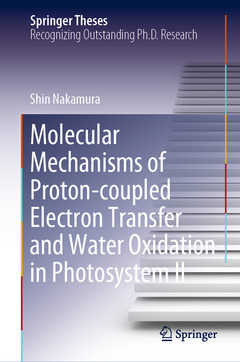Molecular Mechanisms of Proton-coupled Electron Transfer and Water Oxidation in Photosystem II, 1st ed. 2020 Springer Theses Series
Auteur : Nakamura Shin

The book reviews photosynthetic water oxidation and proton-coupled electron transfer in photosystem, focusing on the molecular vibrations of amino acid residues and water molecules. Photosynthetic water oxidation performed by plants and cyanobacteria is essential for the sustenance of life on Earth, not only as an electron source for synthesizing sugars from CO2, but also as an O2 source in the atmosphere. Water oxidation takes place at the Mn4CaO5 cluster in photosystem II, where a series of electron transfer reactions coupled with proton transfer occur using light energy. The author addresses the unresolved mechanisms of photosynthetic water oxidation and relevant proton-coupled electron transfer reactions using a combined approach of experimental and computational methods such as Fourier transform infrared difference spectroscopy and quantum chemical calculations. The results show that protonation and hydrogen-bond structures of water molecules and amino acid residues in the protein play important roles in regulation of the electron and proton transfer reactions. These findings and the methodology make a significant contribution to our understanding the molecular mechanism of photosynthetic water oxidation.
Shin Nakamura is a Postdoctoral Fellow at the University of Rome “Sapienza.” His work mainly focuses on computational and experimental biophysics to better understand the molecular mechanisms of proteins. He received his bachelor’s degree from Aichi University of Education in 2013. He then moved to Nagoya University, where he received his Ph.D. in 2018. He received the Young Talents Award at the International Conference on Photosynthesis Research for Sustainability in 2014 and has been awarded coveted fellowships, including a Research Fellowship for Young Scientists (DC1) in 2015-2018 and Overseas Research Fellowships in 2018-2020, from the Japan Society for the Promotion of Science (JSPS).
Nominated as an outstanding Ph.D. thesis by the Nagoya University, Nagoya, Japan
Reviews photosynthetic water oxidation and proton-coupled electron transfer in photosystem II
Focuses on the molecular vibrations of amino acids residues and water molecules
Date de parution : 01-2020
Ouvrage de 126 p.
15.5x23.5 cm
Disponible chez l'éditeur (délai d'approvisionnement : 15 jours).
Prix indicatif 105,49 €
Ajouter au panierDate de parution : 01-2021
Ouvrage de 126 p.
15.5x23.5 cm
Disponible chez l'éditeur (délai d'approvisionnement : 15 jours).
Prix indicatif 105,49 €
Ajouter au panierThème de Molecular Mechanisms of Proton-coupled Electron Transfer... :
Mots-clés :
Photosynthetic Water Oxidation in PSII; Proton Release Reaction in PSII; Electron Transfer in PSII; Light-Induced Fourier Transform Infrared Difference Spectroscopy; Hybrid QM/MM Approach; DFT and QM/MM Approach; Normal Mode Analysis Using QM/MM Calculations; Grotthuss Mechanism; Asymmetric Electron Transfer of Redox-Active Tyrosines; Proton-coupled Electron Transfer of Redox-Active Tyrosines; systems biology



